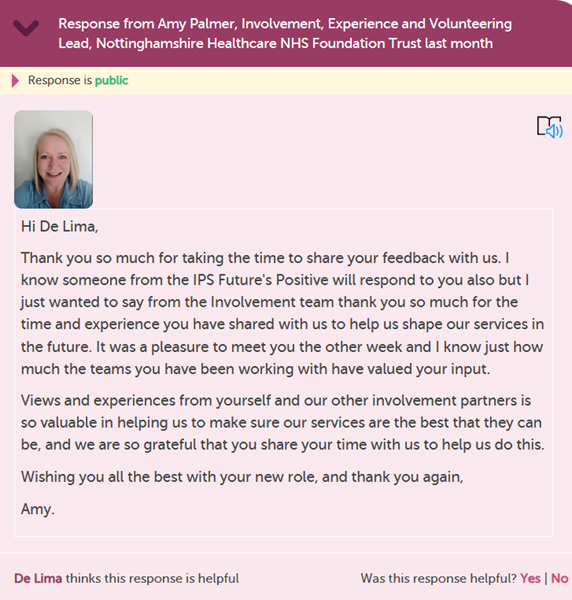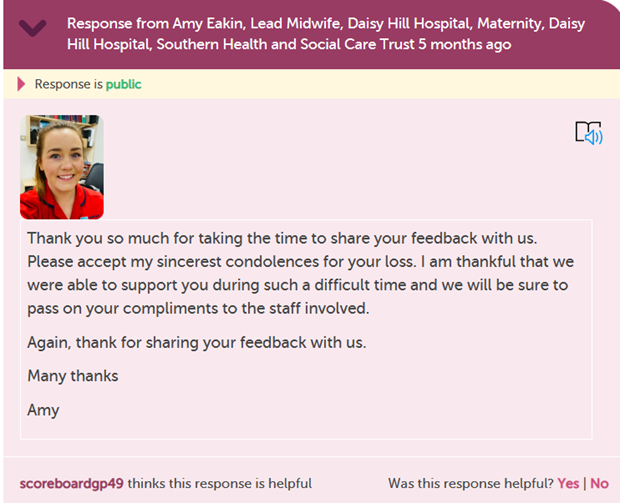
At Care Opinion, we strongly value and appreciate the open, transparent conversations between patients, service-users, relatives, carers, parents and the staff members responding to feedback.
Responding is a key stage in the journey of a story, and creating a well-written response can provide evidence of changes to services, reassurance and sign-posting, information provision, problem solving and demonstrating listening and empathy, to name just a few of the benefits. You can read more about how to respond well to stories on Care Opinion here: Responding well to stories | Care Opinion
As well as the content of your responses, I want to highlight a very important yet simple thing you can do, even before you begin to write your response to an author. First, we have to ask ourselves a few questions;
- What is the first thing an author sees when they read your response?
- How do they know they are being spoken to by a real person?
- Is there anything you can do to show you are a human being, reaching out to another human being?
We have a solution for this. Simply add your picture to your profile, and this will be included in any response you write on the site!
For example, this blog includes my profile picture at the top, so you automatically know who is writing and what I look like. Research shows that our subconscious mind will pick up many things, before we even realise, which shape what we think and how we feel. Willis and Todorov (2006), found that people will often make long-term judgements after seeing an image for just 11 milliseconds. The instant a story author looks at your response, they will form an opinion of you, and if you don't have a profile picture visible, will they see you as a real person?
Rebecca Baines and colleagues (2018), looked at what responders liked to see in replies from staff in services on Care Opinion, and one of the key elements they highlighted was that responders have a profile picture visible to the author and public.
Faces mean a lot to us, from the moment we come into the world. In fact, babies will look at faces of those around them, to help develop cognitive and social functions for the future. Carnevali et al (2022), looked at infant gaze and how important this is, especially during the covid-19 pandemic when face masks were more commonly worn.
"Faces are our primary source of information about other people. We rely on social cues conveyed by human faces to interpret socio-communicative interactions, using information from the face to decode others’ intentions, emotions, and interests." - Carnevali et al (2022)
As adults, we use what we have learned and continue to be drawn to people's faces to help us gauge situations and communicate well. Think about how you feel when someone smiles at you...you might immediately feel like smiling back!
Online interaction may seem to have less opportunities for us to look at each other's faces, however, with technology, we can use digital images and/or videos to improve how we present ourselves and speak to each other. Walther et al (2001) found that online images of people during meetings can help to create 'affection and social interaction' better than when no image can be seen. Imagine an online meeting where no one shows their face...how would this make you feel to attend the meeting? Care Opinion is all about the conversation, and if responders can invite further communication from patients and service users by being transparent about who they are, this conversation can only improve and be more beneficial.
Adding your profile picture essentially makes you human, can bring comfort and ease to the person reading and removes any confusion about who is responding. People will find your responses more helpful, and are more likely to reply back to you as well.
To update your profile picture, simply go to your profile and upload an image:
You can find out how to add your profile picture here: Give your responses a human face | Care Opinion
References:
- First Impressions: Making Up Your Mind After a 100-Ms Exposure to a Face - Janine Willis, Alexander Todorov, 2006 (sagepub.com)
- Responding effectively to adult mental health patient feedback in an online environment: A coproduced framework - Baines - 2018 - Health Expectations - Wiley Online Library
- Is a Picture Worth a Thousand Words?: Photographic Images in Long-Term and Short-Term Computer-Mediated Communication - JOSEPH B. WALTHER, CELESTE L. SLOVACEK, LISA C. TIDWELL, 2001 (sagepub.com)
- Frontiers | Face Processing in Early Development: A Systematic Review of Behavioral Studies and Considerations in Times of COVID-19 Pandemic (frontiersin.org)
A Responder's personal touch - Adding your profile picture
A Responder's personal touch - Adding your profile picture https://careopinionuk-staging.azurewebsites.net/resources/blog-resources/1-images/eb24a21d194c40f48eff4940f89d8ff5.png Care Opinion 0114 281 6256 https://www.careopinion.org.uk /content/uk/logos/co-header-logo-2020-default.pngUpdate from Care Opinion
Posted by Lisa Dendy, Senior Engagement and Support Officer, Subscriber Support, Care Opinion, on
Thanks for your feedback.





